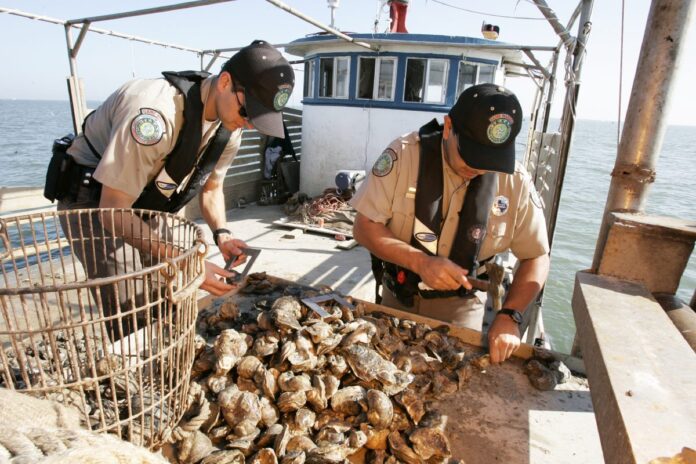HARLINGEN — It’s a pearl of an idea.
Wild oysters already are harvested in a strictly regulated fishery in Texas. But beginning as early as the end of this year, these prized shellfish raised on saltwater farms in the Laguna Madre and elsewhere along the coast could begin hitting seafood stores.
Last year Texas became the final state on the Gulf of Mexico to legalize off-bottom oyster mariculture, a process which uses raised “beds” in shallow waters which oysters attach to, grow from, and eventually are plucked and processed.
Nationally, the farmed oyster business generates about $175 million annually. In Texas, it could quickly become a multi-million-dollar industry, too.
The new oyster mariculture program in Texas couldn’t come at a better time. Global wild oyster harvests have declined by 43 percent since 2000, according to the National Oceanic and Atmospheric Administration.
A key hurdle Texas Parks and Wildlife Department officials face now is identifying the right spots to set the oyster beds. Areas with sea grass beds which serve as nurseries for aquatic species and food for sea turtles are out, as are spots with oil and gas pipelines, existing natural oyster reefs and gulf islands where birds nest.
“You have to grow oysters in clean water, certified by the National Shellfish Sanitation Program,” said Tony Reisinger, Texas A&M AgriLife and Texas Sea Grant’s Cameron County coastal and marine resources agent. “So there are areas closed that are around the waters of South Padre Island, I guess where people live. But further north in the Laguna Madre, there are a lot of areas that are available for it.”
Laguna’s the place
The Texas oyster industry will utilize floating metal cages where the oysters attach themselves and can be easily harvested.
Reisinger said he believes getting into the oyster farming businesses will cost about $16,000 per acre to start.
“They’re going to have to lease, get the oysters, and it’s going to be interesting,” he said. “But all the states in the Gulf of Mexico except for Texas are doing it now.”
He thinks the Laguna Madre, a body of water historically rich in wild oysters, could become some of the most productive waters in the state for the farmed oyster industry, too.
“What’s really unique is that the salinity is higher in the Laguna Madre, and they’ve found that high salinity adds to the good taste of oysters,” Reisinger said. “The Laguna is a hyper-saline lagoon, so that is one of the advantages we could have down here.”
Seeking input
On Saturday, Reisinger and Jo Rampersand, a UTRGV professor with extensive oyster mariculture experience, will host a Texas oyster mariculture stakeholder meeting at the UTRGV Coastal Studies Lab at Isla Blanca Park on South Padre Island.
The 10 a.m. meeting will be an open discussion format for property owners and residents in the area, potential oyster farmers and anyone else to ask questions about the emerging industry and how it may impact the area.
“There are a lot of unknowns and that’s what this fact-finding is, about what people’s concerns are,” he said. “We’re going to have an oyster biologist who is doing research on growing oysters — he’s got a hatchery north of Corpus Christi — Dr. Joe Fox of Texas A&M-Corpus.”
Pluses, minuses
Part of the reason for the stakeholders meeting is to attempt to head off any conflicts on the water or in the community.
“There are some other concerns about growing oysters because they’ll probably have places where there are cages and there could be a lot of conflicts with vessels moving in and around those cages, so you’ll have to mark them,” Reisinger said. “One of the good things is that oyster reefs attract fish.”
Another benefit from oyster farms could actually be cleaner water in the Laguna Madre.
“I don’t think that there are any detriments that I’m aware of except they do produce what they call feces and pseudo-feces,” Reisinger said. “But that really adds to the productivity of the water.
“And one real advantage is that they’ll clean up the water,” he added. “The oysters that are at San Martin Lake, Dr. Hudson DeYoe from UTRGV, one of his students did a study of the impact of those beds cleaning up the water because San Martin, that is the reception area that receives water drained from most of Brownsville, and that water is not very clean when it hits San Martin Lake. But once it passes through those oyster beds, it cleans it up quite a bit.”
Reisinger is confident the addition of a new, relatively benign multi-million-dollar industry that utilizes the natural resources along the Gulf of Mexico is a win-win for Valley residents and the pioneers who will invest time and money into farming these bivalve mollusks.
“It’s going to pay off for all of us,” he said. “It’s just starting out, so the world is their oyster.”
If you go
WHAT — Texas oyster mariculture stakeholder meeting
WHEN — Jan. 25, 10 a.m.
WHERE — UTRGV Coastal Studies Lab, 100 Marine Lab Dr. in Isla Blanca Park, South Padre Island
ONLINE — Livestream at https://utrgv.zoom.us/j/160677994
WHO — Organizers invite all stakeholders who use the Lower Laguna Madre or own property in the surrounding area to share comments about the development of the new industry, oyster farming.





